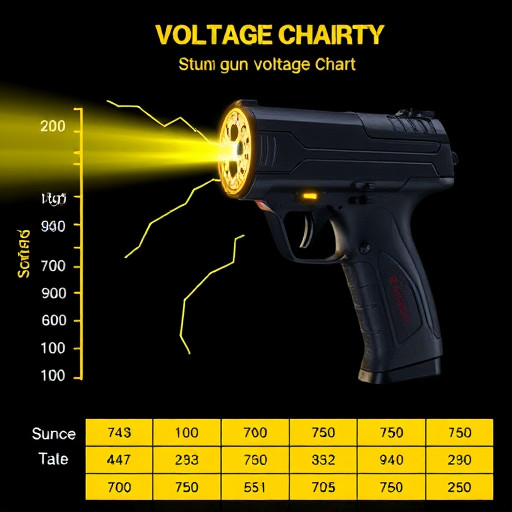“Uncover the power behind your defense with our comprehensive guide to stun gun voltage and amps. Understanding the intricate relationship between voltage, amperage, and stun gun performance is crucial for choosing the right device. This article navigates the ‘Stun Gun Voltage Chart’, offering insights into how voltage levels and current amplitudes affect their effectiveness. We explore factors influencing efficiency and emphasize safety considerations for responsible use, ensuring you’re equipped with knowledge in today’s self-defense landscape.”
Understanding Stun Gun Voltage: A Basic Guide
Stun guns, also known as electronic control devices (ECDs), are non-lethal weapons designed to incapacitate a target through electrical impulses rather than physical force. Understanding the voltage and amps a stun gun delivers is crucial when considering its effectiveness and safety. Stun gun voltage charts provide valuable insights into these key specifications.
Voltage, measured in volts (V), represents the electric potential difference that flows through the body of the targeted individual upon contact or when the stun gun is activated. Amperage, or amps (A), signifies the rate at which this electric current flows. A stun gun’s voltage range typically varies from 50,000 to 130,000 volts, while amp levels can reach up to 4 amps. These values are intended to cause temporary muscle paralysis and disorientation without significant physical harm. Different models and manufacturers may have varying specifications in their stun gun voltage charts, highlighting the importance of considering both factors when choosing a stun gun for personal safety or law enforcement purposes.
The Role of Amperage in Stun Gun Performance
In the context of a stun gun voltage and amps chart, amperage plays a critical role in determining the device’s performance. Amperage, or the rate at which electric charge flows through a circuit, is measured in amps (A). In stun guns, it directly correlates with the amount of current delivered to the target, affecting both the intensity of the shock and its effectiveness. Higher amperage generally results in a more powerful stun, capable of incapacitating an assailant for a longer period. This is why many stun gun manufacturers highlight the amp rating as a key specification in their products.
When examining a stun gun voltage chart, it’s important to look not only at the voltage but also at the maximum amperage the device can produce. A higher voltage doesn’t always guarantee better performance; the actual shock experienced by a target depends on how much current flows through its body. Amperage ensures that the electrical impulse is strong enough to disrupt the nervous system, leading to muscle contractions and temporary paralysis. Understanding this relationship is essential for consumers looking to choose a stun gun that offers both safety and effectiveness in self-defense situations.
Charting the Relationship Between Voltage and Amps
When examining a stun gun, understanding the intricate relationship between voltage and amps is paramount for assessing its effectiveness and safety. A stun gun’s voltage represents the electrical potential it delivers to the target, while amps (or amperage) denote the rate at which electric current flows through the device. The chart illustrating these two parameters offers valuable insights into how a stun gun operates.
By plotting stun gun voltage against amps, users can visualize the device’s performance across various settings. This chart typically reveals a direct correlation; as voltage increases, so does the amperage, up to a certain point. Exceeding this threshold may result in reduced effectiveness or even potential harm to the user and target. Therefore, the stun gun voltage chart serves as a crucial tool for consumers to compare different models and ensure they select a device that aligns with their safety and self-defense needs.
Factors Influencing Stun Gun Efficiency
The effectiveness of a stun gun largely depends on its voltage and current output, as depicted in various stun gun voltage charts. These two factors play a crucial role in delivering a powerful and safe incapacitating shock. Voltage, measured in volts (V), represents the force behind the electrical discharge, while amps (A) indicate the strength of the current flowing through the target.
In terms of stun gun voltage chart comparisons, higher voltage levels generally result in more intense shocks, potentially rendering an attacker unconscious faster. However, excessive voltage can also lead to increased risk of severe injuries or even cardiac arrest if not used properly. Amps, on the other hand, dictate the level of muscle control and immobilization. A stun gun with a high amp output can cause powerful contractions in the target’s muscles, leading to loss of balance and mobility. Combining optimal voltage and amp levels ensures the stun gun delivers an effective, yet safe, incapacitating shock.
Safety Considerations and Responsible Use of Stun Guns
The safe and responsible use of a stun gun is paramount, especially considering the high-voltage capabilities these devices possess. Stun guns deliver electrical shocks through a pair of electrodes that disrupt muscle control in the target, rendering them temporarily incapacitated. As such, it’s crucial to understand the voltage and ampere (amp) ratings detailed in a stun gun voltage chart, which can vary widely between models. Higher voltage doesn’t always equate to better performance; it’s the combination of voltage and current that causes muscular paralysis.
Users must be mindful of their surroundings when deploying a stun gun, ensuring they have a clear path for escape and are not in close proximity to flammable materials or water sources. It’s also essential to familiarize yourself with local laws and regulations regarding stun gun ownership and use. Responsible use includes proper training, maintaining the device, and storing it safely to prevent accidental activation or misuse.
